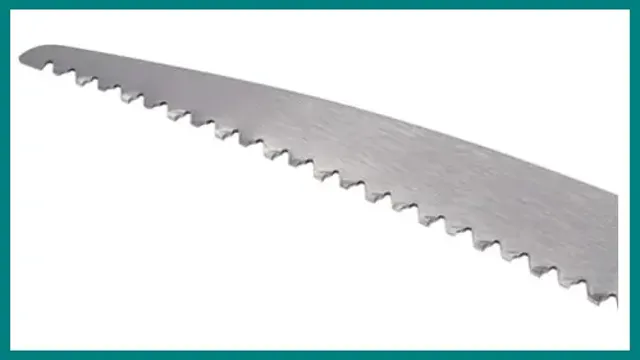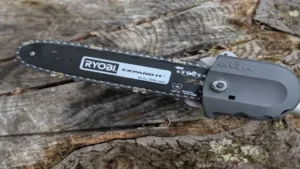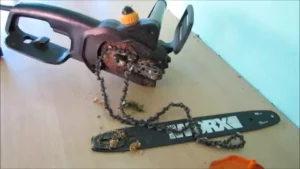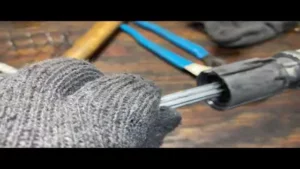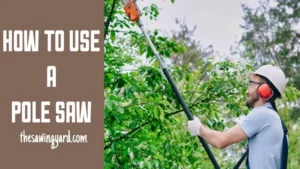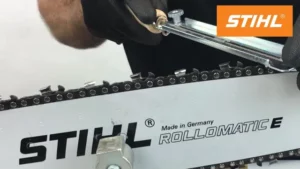If you have a pole saw, you know how important it is to have a sharp blade. A dull blade can make it difficult and dangerous to trim branches and limbs, and can even cause damage to your saw. But how do you go about sharpening it? Don’t worry, it’s not as difficult as it may seem! With the right tools and a little bit of know-how, you can sharpen your pole saw blade and have it working like new again in no time.
In this guide, we’ll discuss the steps you need to take to sharpen your pole saw blade, including the tools you’ll need and the techniques you should use. Whether you’re a seasoned pro or a beginner, you’ll be able to follow along and get your pole saw blade sharpened in no time. So grab your saw and let’s get started!
Understanding Pole Saw Blades
Sharpening a pole saw blade is an essential task to maintain your pole saw’s cutting efficiency and prolong its lifespan. The first step is to clean the blade and remove any dirt or debris that may be on it. Next, use a chainsaw file guide to sharpen the blade’s teeth.
Ensure that you use the correct file size based on the saw’s pitch. Also, file at the same angle as the teeth to avoid changing their shape. After filing all the teeth on one side, inspect them to confirm that they are uniformly sharp.
If not, continue filing with the same pressure until they are. Then, turn the saw blade and repeat the process on the other side. Remember to keep the blade lubricated to prevent rust.
Sharpening your pole saw blade regularly will save you both time and money because it will cut faster and have a longer life span than a dull blade.
Different Types of Pole Saw Blades
If you are looking to purchase a pole saw blade, you will be surprised to learn that there are different types available in the market. Each blade is designed for particular tasks, and it’s important to choose one that suits your needs. One of the most common types is the curved saw blade, which is efficient for pruning and trimming overhead branches.
This blade is curved for precise cuts and is ideal for hard-to-reach areas. Another type is the straight blade, which offers a longer reach and is perfect for cutting thick tree limbs. This blade is also ideal for cutting dense vegetation.
Lastly, there is the bypass blade, which is great for cutting delicate branches. This blade type works like a pair of scissors, ensuring clean cuts without causing damage to the plant. When choosing a pole saw blade, consider the task at hand and the type of branches you will be cutting.
This way, you can ensure that you get the most efficient and effective blade for the job.
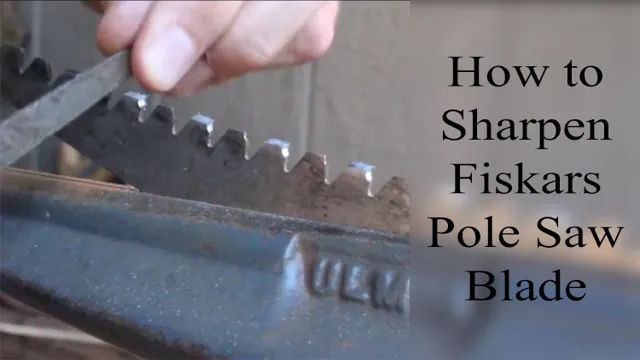
Common Blade Issues and How to Identify Them
When it comes to using a pole saw, one of the most important components is the blade. The blade is the part that actually does the cutting, so it’s crucial to understand its structure and potential issues. One common issue is blade dullness, which can become apparent when the saw struggles to cut through even thin branches.
Other issues include bending or warping of the blade, which can happen if it’s subjected to too much force or if it’s accidentally hit against hard objects like rocks or concrete. Finally, blade damage can occur if the saw is used on the wrong types of branches or if it’s not cleaned and stored properly after use. To identify any of these issues, it’s important to inspect the blade closely, looking for dullness, cracks, or bends.
If any problems are present, it may be time to replace the blade or make repairs before continuing use. For optimal performance, it’s recommended to keep the blade sharp and to avoid putting excessive force on it during use. By doing so, you can ensure that your pole saw operates smoothly and efficiently for years to come.
Preparing your Tools and Workspace for Sharpening
If you’re wondering how to sharpen a pole saw blade, you’ll need to prepare your tools and workspace first to ensure this task goes smoothly. Gather all of your necessary tools, such as a sharpening stone, file, and lubricant, and place them nearby. You’ll also want to clean the pole saw blade and inspect it for any damage before you begin.
A dirty or damaged blade can cause issues during the sharpening process and potentially even ruin the blade. Next, set up your workspace in a well-lit and stable area. It’s important to have a flat surface to work on, along with gloves and safety goggles to protect yourself during the sharpening process.
Once everything is organized, you can begin sharpening your pole saw blade by following the instructions for your specific type of blade. With a bit of practice, you’ll become an expert at maintaining your pole saw and ensuring it’s always ready to tackle your outdoor tasks.
Gathering the Necessary Tools and Materials
When it comes to sharpening, gathering the necessary tools and materials is crucial to achieving the best results. Before starting, make sure you have all the essential items, including a sharpening stone, honing oil, and a cleaning cloth. If you’re using a whetstone, it’s also important to have a flat surface to work on, as well as a non-slip surface to prevent accidents.
Having a workspace that is well-lit and comfortable is also important for ensuring you can focus on the task at hand and avoid any potential injuries. Don’t forget to sharpening gloves to provide extra protection for your hands, especially if you’re using a sharpening machine or power tool. By preparing your tools and workspace beforehand, you’ll not only get better results, but you’ll also minimize frustration and increase your enjoyment of the sharpening process.
Setting Up Your Workspace Safely
When it comes to sharpening your tools, safety should always come first. Before you start, prepare your workspace by cleaning and organizing your tools and work area to avoid any accidents. Ensure that the area around you is clear of any unnecessary items that may cause you to trip or fall.
Also, ensure that you have good lighting to see what you’re doing. The tools that you will be using should be clean and well-maintained. Check that the handles are securely attached and that the blades are sharp.
A dull blade can cause the tool to slip, posing a risk to yourself. Wearing eye protection and gloves can also help prevent any potential injuries. Remember, taking a little time to set up your workspace safely can save you from a lot of unnecessary accidents and injuries.
Sharpening Your Blade
Pole saw blades can become dull over time and use, making trimming and pruning tasks more difficult. Learning how to sharpen a pole saw blade can save time and effort, and improve the longevity of your equipment. To start, secure the pole saw blade in a vise or clamp to prevent movement.
Next, use a sharpening file or stone to evenly sharpen each tooth of the blade. It’s important to maintain the original angle of the tooth to ensure optimal cutting ability. Some experts recommend using a chainsaw file guide to help maintain the correct angle.
After sharpening, remove any metal shavings with a brush, and test the blade’s sharpness with a piece of paper. With proper maintenance, a sharp pole saw blade can improve the efficiency and effectiveness of your pruning and trimming tasks.
Inspecting the Blade and Making Necessary Repairs
Sharpening your blade is an essential part of keeping your tools in good condition. After you have inspected your blade and made any necessary repairs, you may find that your blade needs sharpening. To sharpen your blade effectively, you will need a sharpening stone.
Begin by holding the blade at a 20-degree angle against the stone and rubbing the blade back and forth over the stone in a sweeping motion. Be sure to apply even pressure and check the blade frequently to ensure that your sharpening is consistent. It may take some practice to get the angle just right, but with some patience, you will be able to achieve a sharp edge quickly.
A sharpened blade not only makes cutting easier, but it also improves the overall performance of your tools, allowing you to get more done in less time. Remember, a sharp blade is a safe blade, so be sure to keep your tools sharp and well-maintained.
Choosing the Right Sharpening Tools and Techniques
Sharpening your blade is an essential part of maintaining its performance and longevity. Choosing the right sharpening tools and techniques can determine the effectiveness of your blade’s sharpness. A sharpening stone is a common and affordable choice for sharpening a blade.
It enables you to sharpen the blade’s edge to your desired sharpness level. To use a sharpening stone, place it on a stable surface and hold the blade at a 20-degree angle while running its edge over the stone’s surface. Another option is an electric sharpener, which is beneficial for those who want a quick and efficient sharpening process.
The electric sharpener sharpens the blade’s edge evenly from tip to heel, ensuring a uniform sharpness level. Whatever option you choose, keeping your blade sharp will make it more efficient and enjoyable to work with.
Sharpening the Blade Correctly and Safely
When it comes to sharpening your blade, it’s important to do it correctly and safely. First and foremost, make sure you’re using the right type of sharpener. There are several options out there, including sharpening stones, honing steels, and electric sharpeners.
Choose one that is appropriate for the type of blade you’re working with. Next, make sure the blade is clean and dry before you start sharpening. You don’t want any dirt or grime interfering with the sharpening process.
Once you’re ready to start, hold the blade at the correct angle and apply gentle pressure as you run it over the sharpener. Be patient and take your time – rushing can cause the blade to become damaged or even break. It’s also important to sharpen your blade frequently.
If you wait until it’s completely dull, you’ll have to remove a lot of material to get it sharp again. This can not only be time-consuming but can also cause unnecessary wear and tear on your blade. By sharpening it regularly, you’ll not only maintain its sharp edge but also prolong its lifespan.
Remember, a sharp blade is not only more efficient but also safer to use. A dull blade can slip and cause injury, whereas a sharp one will make precise cuts and slices. By following these tips, you’ll be able to sharpen your blade correctly and safely, ensuring it’s always ready for use when you need it.
Finishing up and Maintenance Tips
If you own a pole saw, it’s essential to keep the blade sharp to ensure it works efficiently and safely. To sharpen a pole saw blade, start by securing the saw in a vise or clamping it to a workbench. Next, use a flat file to sharpen the cutting edges on both sides of the blade.
You can maintain the proper angle by matching the bevels on the blade’s surface. While sharpening, be sure to use even pressure and consistent strokes, and avoid sharpening the same area too many times, which can cause excessive wear and tear. Once you’ve finished sharpening, wipe down the blade with a cloth, and apply oil or lubricant to help prevent rust and extend the blade’s life.
Remember, it’s crucial to maintain your pole saw regularly, including checking the nuts, bolts, and chain tension.
Cleaning and Storing Your Sharpened Blade
Cleaning and storing your sharpened blade is essential for maintaining its longevity and performance. Once you’ve finished sharpening your blade, it’s important to wipe it clean with a dry cloth to remove any debris or metal shavings. Some people like to finish up with a little bit of oil to prevent rust from forming.
When it comes to storing your blade, you’ll want to make sure it’s in a dry place where it won’t be jostled around or knocked over – a protective sheath is often recommended. It’s also important to periodically check the blade for dullness and repeat the sharpening process when necessary. By taking the time to care for your blade properly, you’ll get more use out of it and ensure that it stays in excellent condition for years to come.
Maintaining Your Blade to Keep it Sharp Longer
When it comes to maintaining your blade, there are a few finishing up and maintenance tips you should keep in mind to ensure that your blade stays sharp for as long as possible. First and foremost, always clean your blade after each use to avoid any build-up from developing, which can impact the blade’s performance. When cleaning your blade, it’s best to use a mild detergent and warm water, and then dry it immediately with a soft cloth to prevent any rust from forming.
You can also use a honing rod or sharpening stone to keep your blade sharp over time. By following these simple tips, you can extend the lifespan of your blade and enjoy its excellent performance for years to come.
Conclusion
So there you have it, folks. Sharpening a pole saw blade is a task that requires patience, precision, and a keen eye. Whether you follow the traditional method of using a file or opt for a more modern electric sharpener, the key is to take your time and approach the job with care.
And remember, a sharp blade not only makes your job easier, but also ensures that your trees stay healthy and happy. So go forth and sharpen with confidence, and may your pole saw always be at the ready for whatever tree-trimming adventures lie ahead!”
FAQs
What tools do I need to sharpen a pole saw blade?
To sharpen a pole saw blade, you will need a round file, a file guide, a flat mill file, and a vice.
How often should I sharpen my pole saw blade?
It is recommended to sharpen your pole saw blade after every use or at least once a month, depending on how often you use it.
Can I sharpen my pole saw blade without any experience?
Yes, you can sharpen your pole saw blade without experience. However, it is recommended to follow the manufacturer’s instructions and watch tutorial videos to help you get the job done right.
How do I know if my pole saw blade needs sharpening?
You will know if your pole saw blade needs sharpening if it is difficult to cut through branches, or if the cuts are uneven or jagged.
Can I sharpen a dull pole saw blade or should I replace it?
Yes, you can sharpen a dull pole saw blade. However, if the blade is damaged or has excessive wear, it may be best to replace it.
Can I sharpen a bent pole saw blade?
It is not recommended to sharpen a bent pole saw blade. It is best to replace it with a new one.
How do I maintain the sharpness of my pole saw blade?
To maintain the sharpness of your pole saw blade, it is recommended to clean it after every use, lubricate it, and store it properly. Additionally, be mindful of what you cut with the blade to avoid damaging it.
